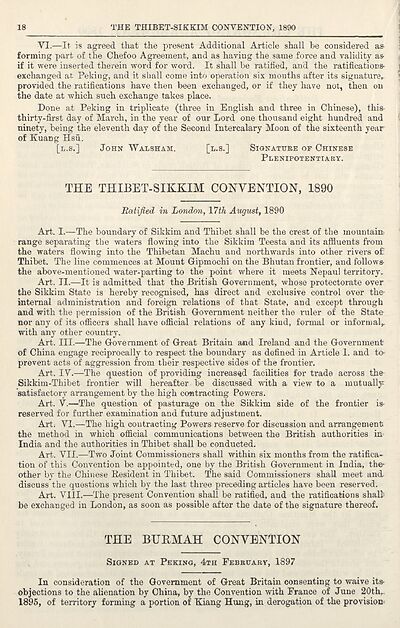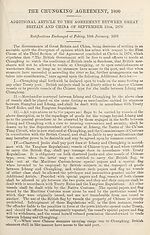1928
(68) Page 18
Download files
Complete book:
Individual page:
Thumbnail gallery: Grid view | List view

18
THE THIBET-SIKKIM CONVENTION, 1890
VI.—It is agreed that the present Additional Article shall be considered as-
forming part of the Chefoo Agreement, and as having the same force and validity as
if it were inserted therein word for word. It shall be ratified, and the ratifications-
exchanged at Peking, and it shall come into operation six mouths after its signature^
provided the ratifications have then been exchanged, or if they have not, then on
the date at which such exchange takes place.
Done at Peking in triplicate (three in English and three in Chinese), this-
thirty-first day of March, in the year of our Lord one thousand eight hundred and
ninety, being the eleventh day of the Second Intercalary Moon of the sixteenth year
of Kuang Hsu.
[l.s.] John Walsham. [l.s.] Signature of Chinese
Plenipotentiary.
THE THIBET-SIKKIM CONVENTION, 1890
Ratified in London, V7th August, 1890
Art. I.—The boundary of Sikkim and Thibet shall be the crest of tbe mountain,
range separating the waters flowing into the Sikkim Teesta and its affluents from
the waters flowing into the Thibetan Machu and northwards into other rivers of
Thibet. The line commences at Mount Gipmochi on the Bhutan frontier, and follows-
the above-mentioned water-parting to the point where it meets Nepaul territory.
Art. II.—It is admitted that the British Government, whose protectorate over
the Sikkim State is hereby recognised, has direct and exclusive control over the-
internal administration and foreign relations of that State, and except through
and with the permission of the British Government neither the ruler of the State
nor any of its officers shall have official relations of any kind, formal or informal,,
with any other country.
Art. III.—The Government of Great Britain and Ireland and the Government
of China engage reciprocally to respect the boundary as defined in Article 1. and to-
prevent acts of aggression from their respective sides of the frontier.
Art. IV.—The question of providing increased facilities for trade across the
Sikkim-Thibet frontier will hereafter be discussed with a view to a mutually
'satisfactory arrangement by the high contracting Powers.
Art. V.—The question of pasturage on the Sikkim side of the frontier is-
reserved for further examination and future adjustment.
Art. VI.—The high contracting Powers reserve for discussion and arrangement
the method in which official communications between the British authorities in
India and the authorities in Thibet shall be conducted.
Art. VII.—Two Joint Commissioners shall within six months from the ratifica¬
tion of this Convention be appointed, one by the British Government in India, the-
other by the Chinese Besident in Thibet. The said Commissioners shall meet and.
discuss the questions which by the last three preceding articles have been reserved.
Art. VIII.—The present Convention shall be ratified, and the ratifications shall
be exchanged in London, as soon as possible after the date of the signature thereof.
THE BUKMAH CONVENTION
Signed at Peking, 4th February, 1897
In consideration of the Government of Great Britain consenting to waive its-
objections to the alienation by China, by the Convention with France of June 20th,.
1895, of territory forming a portion of Xiang Hung, in derogation of the provision*
THE THIBET-SIKKIM CONVENTION, 1890
VI.—It is agreed that the present Additional Article shall be considered as-
forming part of the Chefoo Agreement, and as having the same force and validity as
if it were inserted therein word for word. It shall be ratified, and the ratifications-
exchanged at Peking, and it shall come into operation six mouths after its signature^
provided the ratifications have then been exchanged, or if they have not, then on
the date at which such exchange takes place.
Done at Peking in triplicate (three in English and three in Chinese), this-
thirty-first day of March, in the year of our Lord one thousand eight hundred and
ninety, being the eleventh day of the Second Intercalary Moon of the sixteenth year
of Kuang Hsu.
[l.s.] John Walsham. [l.s.] Signature of Chinese
Plenipotentiary.
THE THIBET-SIKKIM CONVENTION, 1890
Ratified in London, V7th August, 1890
Art. I.—The boundary of Sikkim and Thibet shall be the crest of tbe mountain,
range separating the waters flowing into the Sikkim Teesta and its affluents from
the waters flowing into the Thibetan Machu and northwards into other rivers of
Thibet. The line commences at Mount Gipmochi on the Bhutan frontier, and follows-
the above-mentioned water-parting to the point where it meets Nepaul territory.
Art. II.—It is admitted that the British Government, whose protectorate over
the Sikkim State is hereby recognised, has direct and exclusive control over the-
internal administration and foreign relations of that State, and except through
and with the permission of the British Government neither the ruler of the State
nor any of its officers shall have official relations of any kind, formal or informal,,
with any other country.
Art. III.—The Government of Great Britain and Ireland and the Government
of China engage reciprocally to respect the boundary as defined in Article 1. and to-
prevent acts of aggression from their respective sides of the frontier.
Art. IV.—The question of providing increased facilities for trade across the
Sikkim-Thibet frontier will hereafter be discussed with a view to a mutually
'satisfactory arrangement by the high contracting Powers.
Art. V.—The question of pasturage on the Sikkim side of the frontier is-
reserved for further examination and future adjustment.
Art. VI.—The high contracting Powers reserve for discussion and arrangement
the method in which official communications between the British authorities in
India and the authorities in Thibet shall be conducted.
Art. VII.—Two Joint Commissioners shall within six months from the ratifica¬
tion of this Convention be appointed, one by the British Government in India, the-
other by the Chinese Besident in Thibet. The said Commissioners shall meet and.
discuss the questions which by the last three preceding articles have been reserved.
Art. VIII.—The present Convention shall be ratified, and the ratifications shall
be exchanged in London, as soon as possible after the date of the signature thereof.
THE BUKMAH CONVENTION
Signed at Peking, 4th February, 1897
In consideration of the Government of Great Britain consenting to waive its-
objections to the alienation by China, by the Convention with France of June 20th,.
1895, of territory forming a portion of Xiang Hung, in derogation of the provision*
Set display mode to:
![]() Universal Viewer |
Universal Viewer | ![]() Mirador |
Large image | Transcription
Mirador |
Large image | Transcription
Images and transcriptions on this page, including medium image downloads, may be used under the Creative Commons Attribution 4.0 International Licence unless otherwise stated. ![]()
| Asian directories and chronicles > 1928 > (68) Page 18 |
|---|
| Permanent URL | https://digital.nls.uk/196630756 |
|---|
| Description | (Pagination skips from p. 143-224) |
|---|---|
| Attribution and copyright: |
|
| Description | Volumes from the Asian 'Directory and Chronicle' series covering 1917-1941, but missing 1919 and 1923. Compiled annually from a multiplicity of local sources and research. They provide listings of each country's active corporations, foreign residents and government agencies of all nationalities for that year, together with their addresses. Content includes: various treaties; coverage of conflicts; currencies and taxes; consular fees; weights and measures; public holidays; festivals and traditions. A source of information for both Western states and communities of foreigners living in Asia. Published by Hongkong Daily Press. |
|---|---|
| Shelfmark | H3.86.1303 |
| Additional NLS resources: |

